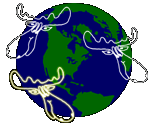
 |
Classification by Environment / Ecotypes |
 Classical Perception
Classical Perception
As you can find in section "Habitat & Species", the normal scientific classification of moose is following the habitat and the discoverers. Adopting that point of view, there are four sub-species of Alces Alces in Eurasia and four more in North-America. A last, ninth sub-species is extinct.
On the other hand all modern moose descend according to the facts of research from the Broad-fronted moose, Alces latifrons, see also "Origins".
 Only
two real sub-species ?
Only
two real sub-species ?
The differentiation taken by the different discoverers, who named the
sub-species, was based on different colours, sizes, antlers.
Usually different
sub-species are distinguished in their genes, which then justifies an own
sub-species.
For the moose the genetic variation is quite little between the sub-species.
All modern moose descend from the region of Yakutia / Manchuria in eastern Asia.
Differences in genes seem to be more depending on isolation by distance, but not
the existence of distinct eastern and western sub-species. Hence, another
perception would be more clear from biological point of view:
Only two sub-species exist:
The European/ West Siberian Moose (Alces alces alces) |
How could variations in size and colours be explained then if only two major races exist? It is the environmental perception helping out - the ecotypes built by food supply, terrain, temperatures being specific for a region, latitude, type of landscape and the natural selection finally giving the environmentally best-suited animals the best chance for survival and reproduction.
 Taking an environmental attitude - Body size
Taking an environmental attitude - Body size
The body size is mainly dependant on the environment:
If the food supply is generous, the animals get bigger. Looking at geographical
regions, it can be observed, that moose in the area of the 65th parallel
with much and high-quality moose browse reach 550-630 kg, while at the 40th
parallel with food not being that perfectly suited moose only reach weights
of around 250-350kg.
An example: The Alaskan moose is huge, as in that region the flora has long periods of growth from spring to autumn with very long summer-days and cool nights. This leads to above-average photosynthesis and very good nutrient concentration. Additionally Alaska was late populated by moose, therefore plants have not adapted by building defense mechanisms that much (i.e. toxins in foliage and bark).
Another one: Above 65th parallel summers are short, there are too few days with a sufficient food supply, therefore moose are small.
And a last one: Below the 65th parallel it is too warm with too few hours of sunshine. Therefore plants grow too fast and don't keep a young stage long enough, where their are easy to digest for moose (when they get older they build too many toxins).
 Taking an environmental attitude - Colour
Taking an environmental attitude - Colour
Variations in moose colour can be explained by their habitat in many cases:
Moose living mainly in free areas, such as Northern and Western North America,
are usually brighter and more colourful than those mainly staying in forested
areas (Eastern North America), where they are often very dark.
The brighter the environment, the more likely the moose has a bright back to maintain a high reflectivity of it's body in order not to warm up that much. Moose can't sweat, and when being highly active, especially during the rut, the bright back helps to keep body temperatures at a moderate level.
Of course variations in colour are common in general, meaning that just taking the moose's colour as indicator for the region or a sub-species would be too imprecise.